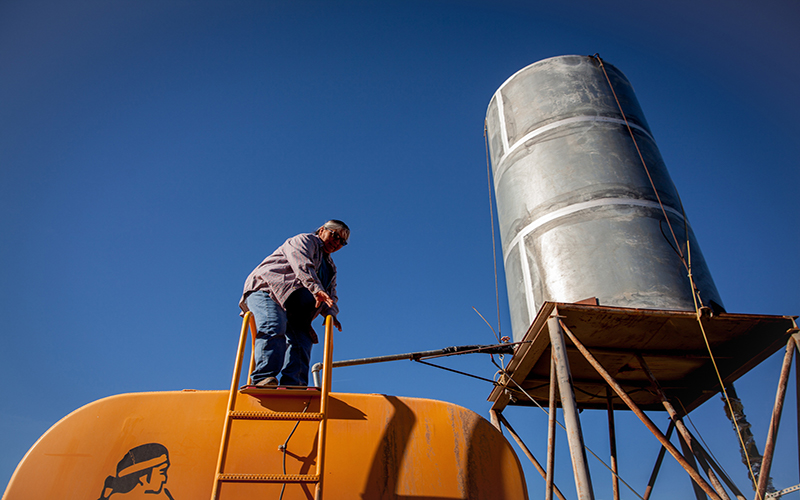- Slug: BC-CNS-Tribal Water,670
- File photo available (thumbnail, caption below)
By Sarah Oven
Cronkite News
WASHINGTON – Arizona tribal officials told a Senate committee Wednesday that the federal government can help address a crisis with water infrastructure on their lands through more funding, and less meddling.
Navajo Department of Water Resources Director Jason John and Colorado River Indian Tribes Chairwoman Amelia Flores made the comments during a Senate Indian Affairs Committee hearing on water infrastructure for Native communities. Leaders of Oregon and Alaska tribes also testified at the hearing.
John told the committee that the Navajo Nation has identified water development “as one of its highest needs,” and has put $200 million of tribal funds toward water projects in recent years. But that barely puts a dent in the nearly $4 billion in projects the tribe has identified, for everything from drinking water to irrigation to drought response.
“Although Indian Health Service has done good work to provide water with limited funding and staffing, the needs far exceed what the program can accomplish without additional staffing and project funding,” John testified.
“Adequate funding must be provided to get projects shovel-ready so that projects can be built in less time when funding becomes available,” he said.
John said the tribe needs more than funding for construction projects. More staff are needed to best assess the needs of the tribe and to most effectively plan the projects, he said.
“Overcoming the legacy of neglect and infrastructure deficits on the Navajo Nation will require an aggressive water development program,” said John, who told the committee there were “far too many projects” to discuss in a single hearing.
Flores said that if her tribe spent all of the funding it is scheduled to receive under the American Rescue Plan, it would cover only about half of the need for water resources and leave nothing for pandemic relief or government operations.
“The programmatic, annually appropriated funding for this work is not sufficient to provide access to clean water for all tribal nations,” Flores said.
But she also said it’s not just lack of money that’s holding tribes back, but federal laws that hamstring their ability to make decisions for themselves.
“You don’t just need to throw federal money at the problem,” Flores told the committee. “It helps of course, but it’s not the only thing holding tribes back.”
She pointed to laws like the Indian Non-Intercourse Act, one of the “many legal and government hurdles that make efficient water infrastructure challenging.” She said the law makes it impossible for her tribe and others to lease water without first getting congressional approval.
“Congress has given that right to many tribes in their water settlement, but for those of us with decreed water rights, we still can’t lease our water,” Flores said. “If given that right, we would use it to preserve the life of the river.”
Flores also criticized the Bureau of Indian Affairs’ management of the Colorado River Irrigation Project, which she said had led to maintenance shortfalls that, in turn, have resulted in the tribe not getting water it deserved.
The hearing comes as the Biden administration weighs a massive infrastructure bill that has sustainability at the forefront of its design.
It also comes as Arizona and the Southwest struggle through a historic drought that has lowered availability of water from the Colorado and other rivers even as demand has steadily increased. This year, a drought contingency plan was partially put into action for the first time.
Flores said it was her tribe and the Gila River Indian Community that “brought solutions to the table” when water was needed under the drought contingency plan. She stressed the importance of including tribes in any discussion of water rights, and expressed hope the newly sworn-in Interior Secretary Deb Haaland, the first Native American to head a Cabinet agency, will listen.
“As prolonged drought and climate change continue to impact our basin, it is my hope that the committee will insist that Secretary Haaland and her staff engage tribal leaders as they rework these guidelines in coming years,” she said.
For more stories from Cronkite News, visit cronkitenews.azpbs.org.
^__=
Web links:
_ Hearing: https://www.indian.senate.gov/hearing/business-meeting-consider-s-421-s-789-oversight-hearing-build-back-better-water
_ John testimony: https://www.indian.senate.gov/sites/default/files/2021-03-22%2024March2021_Testimony_draft%20-%20final.pdf
_ Flores testimony: https://www.indian.senate.gov/sites/default/files/2021.3.19%20%20Oral%20CRIT%20SCIA%20Water%20Infrastructure%20Hearing%20Testimony%20V2.pdf
_ Biden infrastructure talks: https://www.whitehouse.gov/briefing-room/statements-releases/2021/03/04/readout-of-president-biden-vice-president-harris-and-secretary-buttigiegs-meeting-with-house-members-on-infrastructure/
_ Drought Contingency Plan: https://www.cap-az.com/documents/departments/planning/colorado-river-programs/CAP-FactSheet-DCP.pdf
^__=
Water hauling the only way to deliver water on parts of the Navajo Nation, which says it has almost $4 billion in needed water projects. In this 2017 photo, Darlene Arviso fills her truck with well water for deliver from the St. Bonaventure Indian Mission and School. (Photo by Maria Esquinca/News21)
